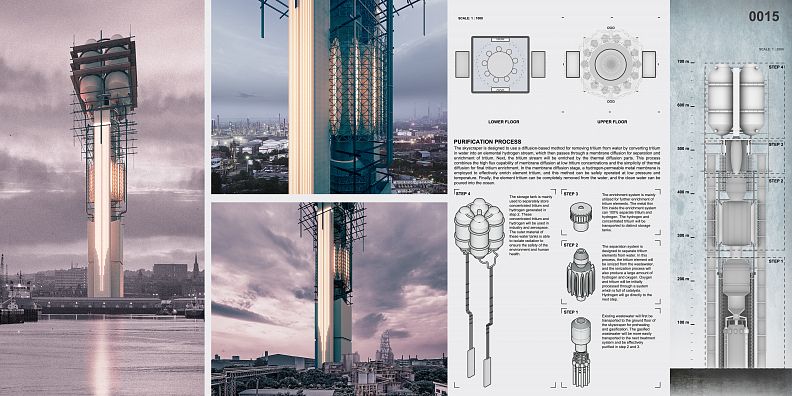Tritium Elimination Skyscraper

Project idea
Nuclear-contaminated water sources have caused environmental issues since Fukushima nuclear power plant in Japan was destroyed by a tsunami triggered by an earthquake in March 2011, and the radioactive sewage is produced during the process of cooling disused nuclear power plants. Under the influence of the earthquake and tsunami, the operating equipment and cooling system of the nuclear power plant have been completely destroyed. In order to avoid the meltdown of this nuclear power plant, workers have continuously poured water into it to cool the core for the past ten years. In fact, the water used for cooling will attach a large amount of radionuclide after being injected into the core; therefore, those water cannot be reused. After preliminary nuclide purification, the radioactive sewage which has basically been purified will be stored in water tanks, but the tritium element in it is still difficult to be removed. Nowadays, a large amount of sewage containing tritium element urgently needs to be properly treated.
Project description
In 2020, some expert teams propose to dump wastewater into the ocean, and experts point out that the ocean can dilute wastewater containing tritium. However, the impacts of tritium elements to all creatures have not been tested yet. Once the wastewater flows into the ocean, these tritium elements could accumulate in marine organisms and eventually reach the human body through the food chain. What’s worse, these tritium elements could flow to all parts of the world along with ocean currents. In my opinion, there should be a better solution to deal with the wastewater in an eco-friendly way. Therefore, the Tritium Elimination Skyscraper is designed to purify the wastewater and recycle the tritium elements for industrial purposes. Meanwhile, the skyscraper can be quickly built and put into the work of purifying wastewater.
Technical information
The skyscraper is designed to use a diffusion-based method for removing tritium from water by converting tritium in water into an elemental hydrogen stream, which then passes through a membrane diffusion for separation and enrichment of tritium. Next, the tritium stream will be enriched by the thermal diffusion parts. This process combines the high flux capability of membrane diffusion at low tritium concentrations and the simplicity of thermal diffusion for final tritium enrichment. In the membrane diffusion stage, a hydrogen-permeable metal membrane is employed to effectively enrich element tritium, and this method can be safely operated at low pressure and temperature. Finally, the element tritium can be completely removed from the water, and the clean water can be poured into the ocean.



